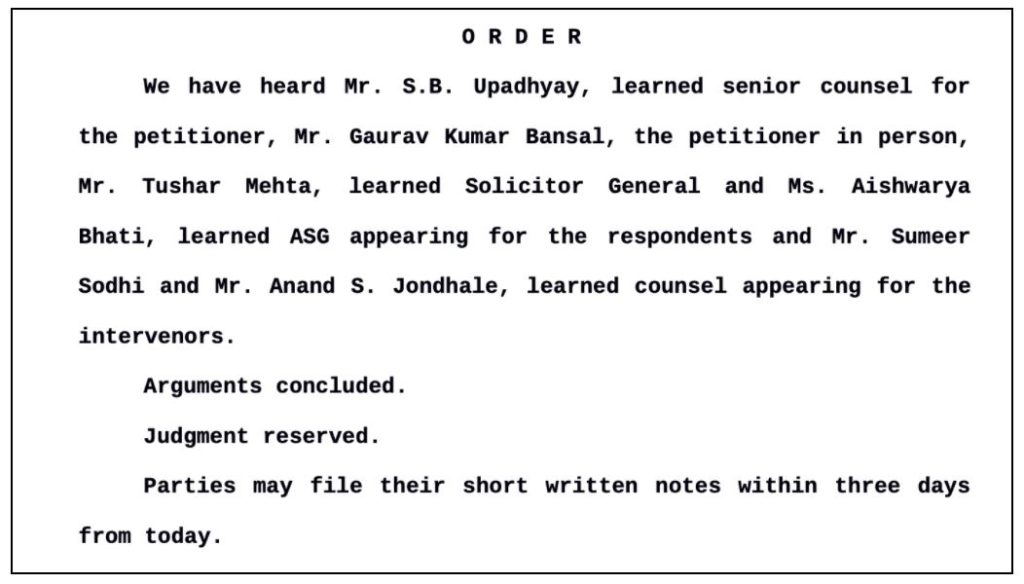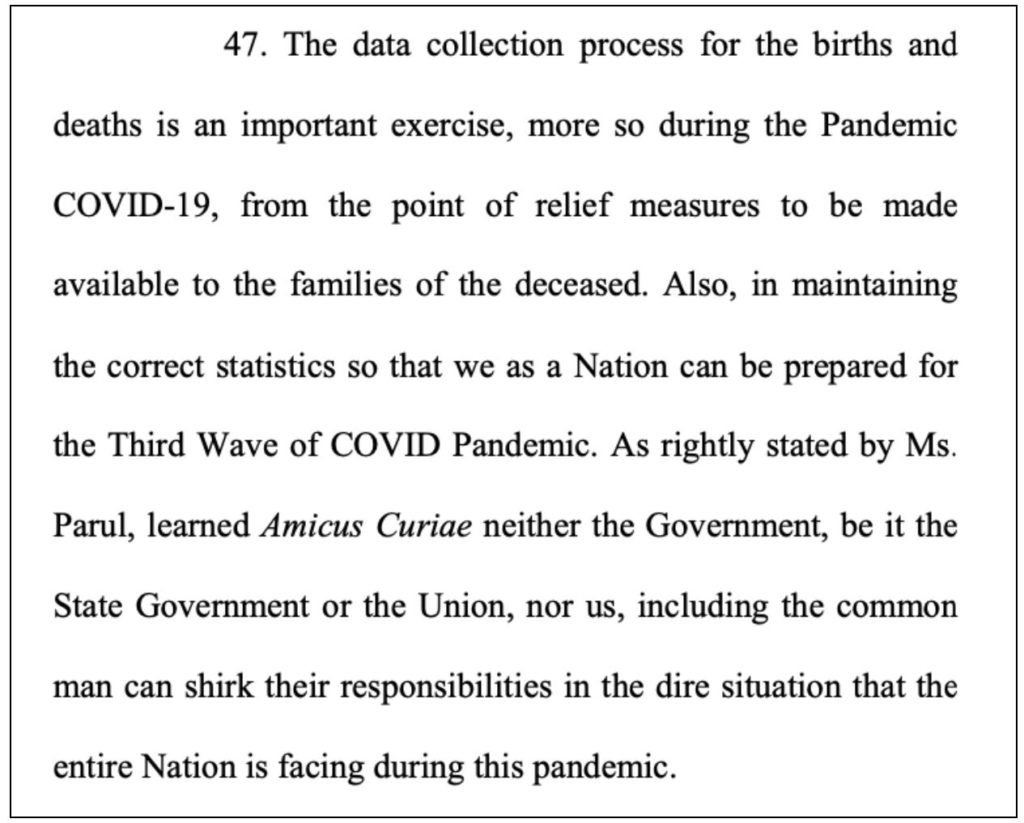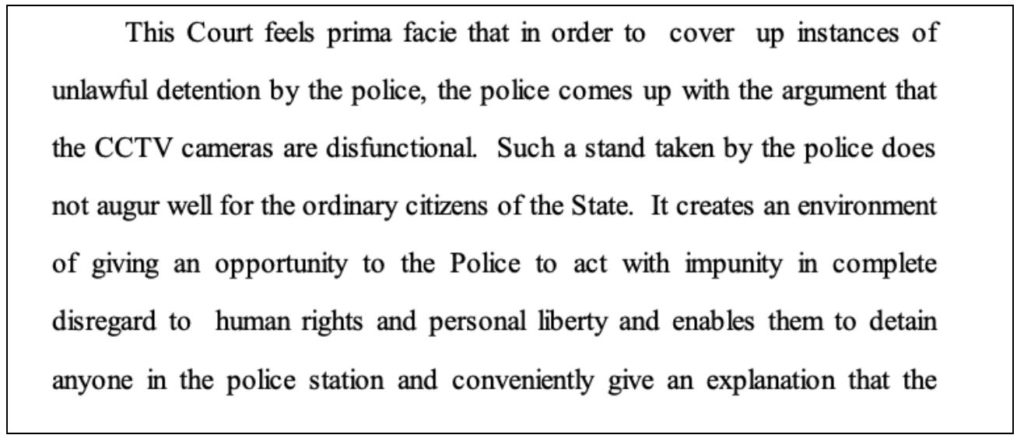In this roundup of court judgements, we look at Constitutional Courts’ remarks & directions on ex gratia compensation to COVID-19 victims, dissemination of COVID-19 death statistics, illegal detention, and miscarriage of justice.
Supreme Court: Reserves judgement on plea for ex-gratia compensation to COVID-19 victims
The supreme court was hearing pleas seeking ex gratia monetary compensation of Rs. 4 lakhs or notified ex gratia monetary compensation to the families of deceased who have succumbed to the pandemic of COVID-19.
The plea emphasises that not only is it the legal obligation of the State to provide adequate relief to the victims of COVID-19 and their family members under the State Disaster Response Fund (SDRF) as it is a “notified disaster”, but it is also the Constitutional obligation of the State to take care of the victims of the calamity and their families. Section 12 of the Disaster Management Act, 2005, states that the National Authority shall recommend guidelines for minimum standards of relief to be provided to persons affected by disaster, which shall include ex gratia assistance on account of loss of life.
The plea, additionally, submits that it is the right of the family members to know the real cause of death of their family member on any official document, and are therefore seeking directions to States to issue death certificates/any letter to the families of the deceased stating the cause of death. The bench acknowledged the submission of the Petitioners that the guidelines for a minimum standard of relief for ex gratia assistance required a death certificate. However, death certificates of COVID-19 victims did not mention the cause of death, thereby leading to difficulties for the families who would have to run from pillar to post to receive the compensation. To this end, the Court had directed the Central Government to bring on record any policy or guidelines pertaining to death certificates issued to COVID-19 patients, including guidelines by the Indian Council of Medical Research (ICMR).
The Central Government initially informed the Supreme Court that the Centre was actively considering the issues raised in the pleas and afterwards, the Centre informed the apex court that payment of ex gratia compensation to all deceased persons due to COVID-19, is beyond the fiscal affordability of the Governments, as the finances of State Governments and the Central Government are under severe strain, due to the reduction in tax revenues and increase in health expenses on account of the pandemic. The submissions have been made by the Ministry of Home Affairs through an affidavit.
The Ministry of Home Affairs (MHA) submitted that if ex gratia of Rs. 4 lakhs are given for every person, who loses life due to COVID-19, the entire amount of SDRF may possibly be spent on this item alone. While acknowledging that the affected families need help and support, MHA has stated that it is wrong to state that the help can be provided only through ex gratia assistance as that would be a ‘rather pedantic and narrow approach’. According to MHA, health interventions, social protection, and economic recovery for the affected communities would be a more prudent, responsible, and sustainable approach.
Further, MHA has stated that there is no precedent of giving ex gratia for an ongoing disease or for any disaster event of long duration, extending for several months or years, and granting ex gratia for one disease while denying the same for those accounting for a larger share of mortality, would not be fair and would create unfairness and invidious discrimination.
The arguments of both sides have concluded in the case and the court reserved the judgment.

Bihar HC: State obligated to provide accurate and regular information on deaths occurred during the COVID-19 pandemic.
In the case Shivani Kaushik vs. Union of India, the high court observed that the Government, be it for whatever reason, is reluctant to put in the public domain the number of deaths that occurred in Bihar during the last one year i.e., during the time of COVID-19 pandemic.
The issue brought to light was as to whether more than ten crore people of the State of Bihar have a right to know, on a digital platform, the number of deaths that occurred in Bihar during the time of COVID-19. And whether the Government has a corresponding duty to disclose either voluntarily or as mandated by law. The court maintained that the Government has a responsibility to provide accurate, reliable, and up-to-date information to the general public. The mandate to do so also flows under the provisions of the Right to Information Act, 2005 (RTI Act). The provision of the RTI Act casts a duty upon all public authorities to suo motu provide and disseminate information unless it is protected by law.

The judgement explains that on 31 May 2021, the Chief Secretary, Government of Bihar filed an affidavit seeking time to upload the information of deaths resulting from COVID-19. However, despite repeated assurances, the high court found that the Digital Portal was not being uploaded periodically by the functionaries.
In conclusion, the high court held that the resistance by the state government to furnish the said information is uncalled for, for such action is neither protected by any law nor in consonance with good governance’s settled principles. Considering this, the court issued the following directions:
- The Registration of Births and Deaths Act, 1969 and the Right to Information Act, 2005, give a right to a person in almost unequivocal terms of their access to information. Therefore, the Government of Bihar is under an obligation to the citizens of India, more so the residents of the State, to provide information on the Digital Portal the number of deaths, be it for whatever reason, that have occurred during the COVID 19 Pandemic.
- The State is under a duty under the Registration Act to facilitate the right of any person to cause a search, and for that to happen, the Digital Portal maintained by different entities must be updated immediately.
- This Court has found the Digital Portals maintained by the Government to be opaque, and therefore directed the concerned authority to take steps to integrate ease of access, in consonance with the larger aims of the Digital India program.
- The information to be updated regularly on the digital portal shall be done in line with the right to privacy, recognized under the Constitution.
- Elected representatives upon whom an obligation has been placed, by relevant statutes/orders, as discussed, are duty-bound to disclose the number of deaths that occurred in their constituencies within twenty-four (24) hours.
In a similar vein, the Madras High Court noted that all over the country, there are grievances that all the deaths that have been caused by the pandemic may not have been appropriately recorded.
The high court was hearing a plea that sought framing and implementation of an effective policy to ensure that cause of death is properly and correctly mentioned in the relevant certificate/official document for all cases of COVID-19 related deaths in accordance with the law, ICMR guidelines, and other relevant parameters. The high court sought responses from the State & Central Government and has posted the matter for further hearing on 28 June 2021.
Madhya Pradesh: Police often claims dysfunctionality of CCTVs to cover up instances of unlawful detention
In the case Ritwik Kaushal vs. State of Madhya Pradesh, the high court made a prima facie observation that in order to cover up instances of unlawful detention, the police often take a false stand that the CCTV cameras are dysfunctional.
The court was hearing a plea against the alleged unlawful detention of the petitioner by local police authorities. The petitioner alleged that he was unlawfully picked up on 22 February 2021, was taken to the Piplani police station, and detained for two days. The petitioner’s family was informed that he will be released in some time but subsequently, an FIR was lodged alleging that he was arrested on 23 February for possession of drugs. The petitioner, therefore, filed a plea stating that the CCTV footage from 22 February till 24 February 2021 of the Police Station Piplani be secured and brought before the Court, which would clearly reveal that the petitioner was in unlawful custody during that period.
In response, the prosecutor submitted that the CCTV footage of the said period cannot be shown as that would reveal the identity of the source informant. However, the police report that was given to the high court revealed that the CCTV cameras in the Piplani police station were non-functional from 17 February 2021.
The high court noted contradiction in the statements made by the local Police and by the Prosecutor and observed that the case discloses a larger issue.
The judgement notes that such a stand creates an opportunity for the police to act with impunity in complete disregard to human rights and personal liberty and conveniently give an explanation that the CCTV cameras were dysfunctional during the period which the citizen says that he was unlawfully detained in the police station.

In conclusion, the court has summoned DIG- Bhopal (Urban), and SP (South Bhopal) on the next date of hearing and has instructed them to explain as to why the cameras were dysfunctional from 17 February 2021, whether the concerned authorities were informed about the dysfunctionality by the SHO of PS Piplani, and if they were informed, what were the steps taken by those officials to have the cameras rectified in the shortest possible time.
Uttar Pradesh: Incomplete gang-charts result in easy bail, giving ample room for miscarriage of justice
In the case Nishant v. State of Uttar Pradesh (UP), the high court took note of incomplete and defective gang-charts being filed under the UP Gangster Act 1986, which ultimately helps alleged gangsters in “easily obtaining bail”, thereby threatening the order of the civil society.
The high court was hearing bail applications filed by alleged gangsters and noted that the charts filed by the police against the four accused suffered from the same vice of law i.e., ‘incomplete and defective gang chart’ which does not indicate the accused’s complete past credentials, giving ample room for miscarriage of justice, resultantly, the accused-applicant tends to be bailed out easily.
The current judgement highlights the adverse impact of defective gang-chart on bail as well as a trial of the accused concern. The Uttar Pradesh Gangsters and Anti-Social Activities (Prevention) Act, 1986 exhaustively defines gangsterism and gangsters and allows the State to make special provisions to curb and cope with “gangsters and their anti-social activities” and for other connected matters. The State legislature brought into force the above-mentioned legislation on 15 January 1986 with a view to handle the menace of ‘Organized Crime’ in the State in a more effective way.
However, the court notes that no rules have been framed even after a lapse of 35 years of the said enactment by the State Government. Taking the advantage of this void when there are no rules or procedures for the present Act, only incomplete and half-backed gang-charts were prepared by the informants of different bail applications which were later mechanically approved by the responsible higher police authorities of the district, against that Gang.
In this respect, the Court made two major observations:
- Incomplete and defective gang chart which does not indicate the accused’s complete past credentials, giving ample room for miscarriage of justice, resultantly, the accused-applicant tends to be bailed out easily.
- The law is often misused, and the named accused is fastened with additional criminal liability under the Gangsters Act.
In conclusion, the high court directed the Principal Secretary (Home), Lucknow and the Director-General of Police, Lucknow to frame proper Rules under the 1986 Act, latest by 31 December 2021. Meanwhile, they were asked to issue a proper circular to all the SSP/SPs of the District to appoint any officer (at least CO Rank), to become the author of gang chart and act as Nodal Officer of all the police stations within the district. The judgement also laid down the elements that a cogent gang-chart must reflect:
- Name, sex, permanent address of the accused
- The number of total cases to his credit either in his individual capacity or as a member of the gang.
- If there are successive prosecution under the U.P. Gangster Act, then details of previous cases in the form of “Addenda”.
- Stage of the trial of those cases before the trial court.
- Family background, his social, financial status of that accused including his ill-gotten wealth.
- Whether he has misused the liberty of bail granted to him earlier by the law courts and has indulged in subsequent offences.
- Area of operation of that gang within the district alone or in the adjoining districts or has gone beyond the limits of State and lastly types of cases, meaning thereby the gang is having expertise in committing a particular type of offence or assorted crimes and lastly his general reputation in the locality.
Further, the high court emphasised that SP/SSP of the district after making an in-depth probe and cross-check, regarding the authenticity of the gang chart shall approve it after putting his signatures. Any laxity by the authority concerned in preparing the gang chart would warrant serious consequences on his own shoulders. The Special Judge (Gangster Act) which is operational in every Session/Division in the State were also directed to speed up the trial and make all necessary endeavours to conclude the same within a year of submission of the charge sheet. The proceeding under the U.P. Gangster Act shall be given priority over any other trial.
Featured Image: Important Court Judgements


